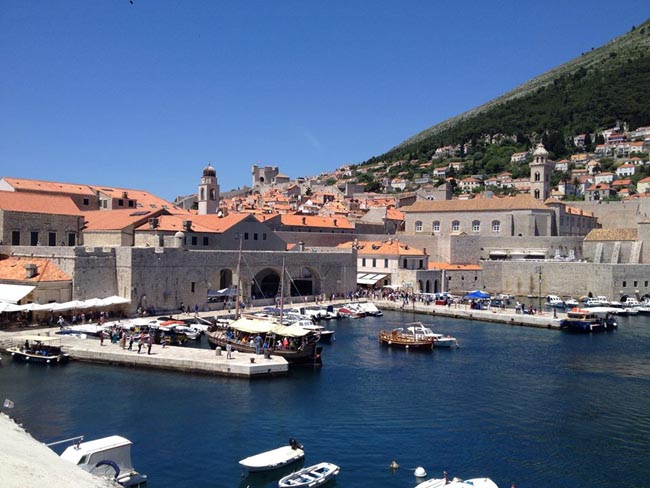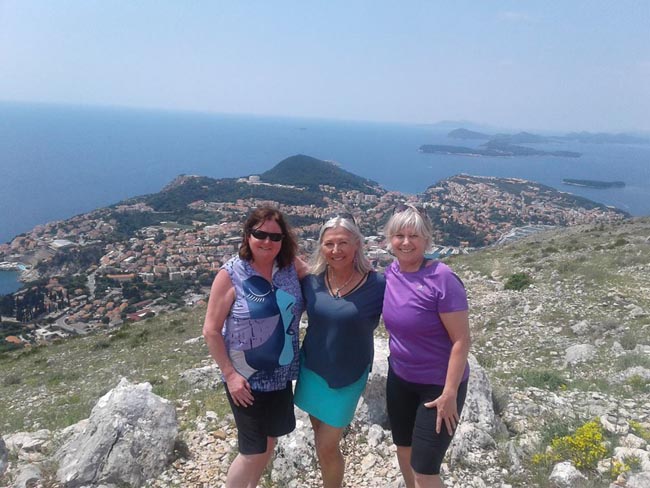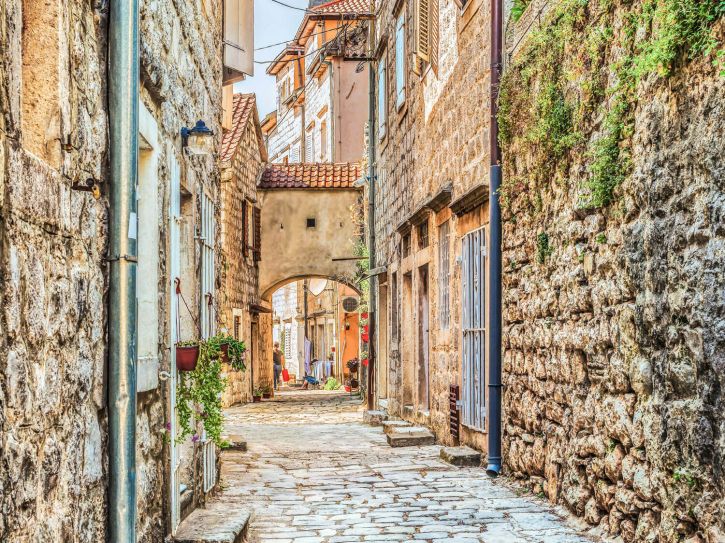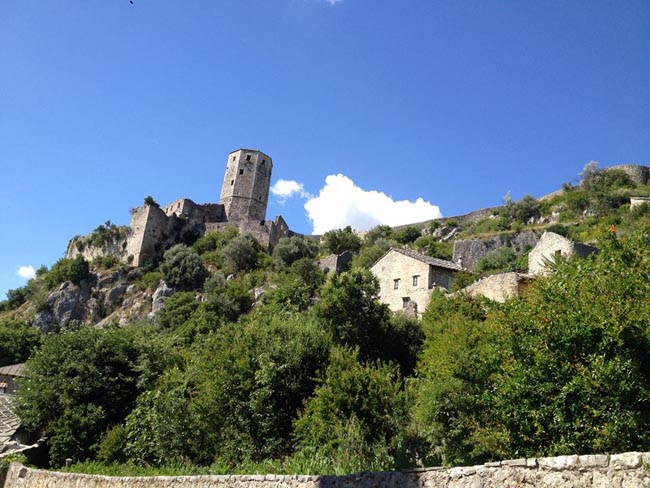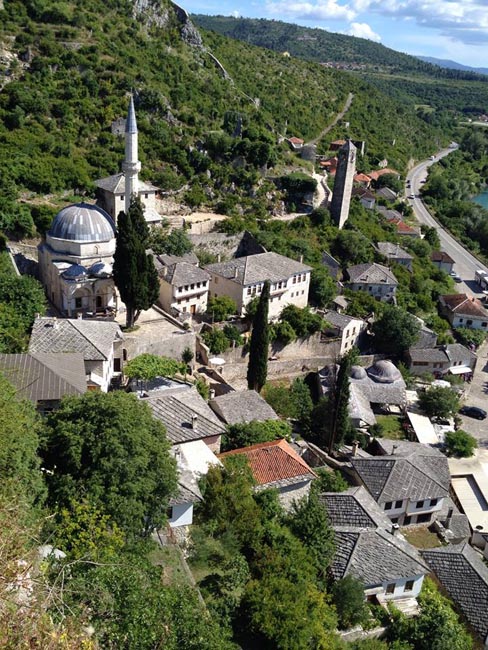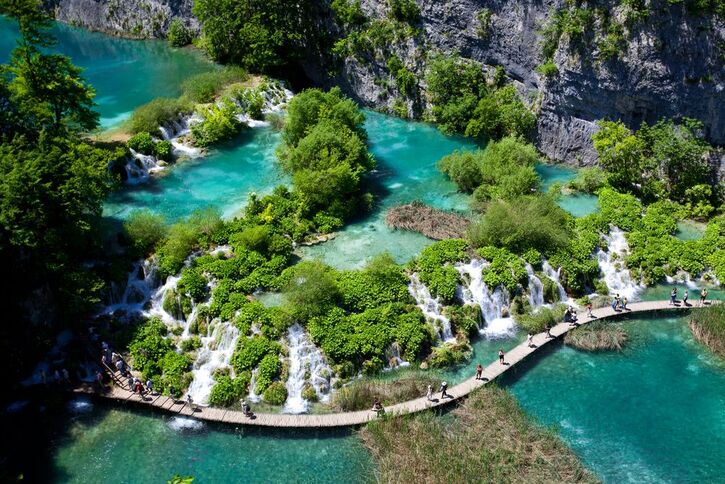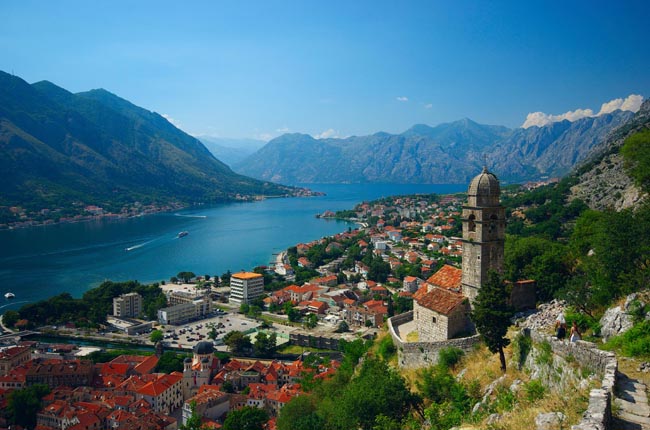** FOR 2026, this tour will be replaced by tour code XCM **
Embark on a captivating journey through Croatia and Montenegro. Explore the medieval charm of Kotor, a UNESCO World Heritage Site, and wander through the stunning walled city of Dubrovnik. Hike through the lush landscapes of Plitvice Lakes National Park and soak up the sun on the idyllic islands of Korcula, Hvar, and Brac. Immerse yourself in the rich history and culture of these two beautiful countries, from ancient ruins to modern cities.
Prices below are per person, twin-sharing costs in US Dollars (USD). Pricing does not include airfare to/from the tour and any applicable taxes. For single supplement rates and taxes (if any), please refer to below Prices & Dates table. For general information on flights to/from the tour, click here.
Your Travel and Accommodation Arranged For You
Tips Included for Driver, Restaurant Staff, Local Guides
Authentic Local Experiences With Lots Of Inclusions.
Select a date below to reserve your spot:
** FOR 2026, this tour will be replaced by tour code XCM **
Optional Single Supplement: $1050 USD (number of singles limited).
Download Itinerary
Day 1 Arrival in Kotor
Today we arrive in Kotor, Montenegro [the closest airport is Tivat (TIV)].*
A UNESCO World Heritage Site, Kotor was inhabited even at the times of Illyrians and Romans. Its history is also entwined with that of the Venetian Empire. Within its walls, the city of Kotor has retained a mediaeval feel. A map of the old city shows hardly a single right angle; the town consists of a maze of tiny alleys that meet unexpectedly to form "squares" that are anything but square. Overshadowed by both towering cliffs and the high walls of four-storey stone houses, some of these narrow lanes must never see sunshine. One of the great pleasures of Kotor is wandering at random through this little labyrinth.
PLEASE NOTE: We rate this tour as "moderate" in terms of its physicality. Though all of our hikes are "day walks" and therefore optional, in order to fully enjoy the areas visited, you should be adequately fit in order to safely and comfortably participate in each day's activities. If you think that this trip might be too strenuous for you, we recommend our non-hiking Adriatic trips.
* If you are having difficulty finding satisfactory air connections from your home airport, some passengers have had success flying into Dubrovnik instead and making their own way to Kotor.
Overnight in Kotor.
Included Meal(s): Dinner
Day 2 Kotor Touring
This morning we enjoy a walking tour* to see a number of the city's fortifications and monuments dating from the time of Venetian rule, including the Cathedral of St Tryphon, which contains a rich collection of artifacts. Older than many famous churches and cathedrals in Europe, the Cathedral of St. Tryphon has a treasury of immense value. In its interior there are frescos from the 14th century, a stone ornament above the main altar in which the life of St. Tryphon is depicted, as well as a relief of saints in gold and silver. The most representative works of Kotor's masters and craftsmen are kept in this Cathedral, making its collection quite unique.
Later we'll climb the city walls to the Fortress of St Ivan, passing the Chapel of Our Lady of Salvation along the way. The steps begin at the northwest corner of the city. It's a stiff climb so don't set off without something to drink: there are 1,350-1,500 steps according to various guidebooks. From the highest point the ground drops away sharply on three sides with the rooftops of Kotor immediately below. To the north you can see the whole inner part of the bay. Look out for a dome near the shore to the west -- it belongs to the implausibly large church in the village of Prcanj.
When we have finished admiring the view we can scramble around the crumbling ruins with a freedom rarely found in more litiginous countries -- the only ones likely to challenge you are the goats. After our hike, you'll have some free time to enjoy Kotor. Browse the town at your leisure and discover souvenir, antique and craft shops, boutiques and market stalls.
* Depending on season and concerns about weather, your Tour Leader may elect to hike first thing and then tour Kotor in the afternoon.
TOTAL WALKING TIME +/- 3 HOURS. Elevation gain/loss 530m/1,738 ft (this is likely the most strenuous hike of our trip, given it's steepness and amount of vertical rise).
Our hikes: Because some hikes can/may be adjusted at the discretion of your Tour Leader depending on things like weather and group interest, the final distances/durations of our hikes as indicated in our itinerary should be taken as guidance only. In the meantime, however, we can advise that, generally-speaking, our walks are leisurely on well-trodden pathways over undulating terrain (some walks are downhill), 2-5 hours in overall duration with plenty of breaks for refreshment, photos, and taking it all in.
Overnight in Kotor.
Included Meal(s): Breakfast and Dinner
Not finding what you're looking for?
Our specialists can take away the stress and create a private custom tour tailored to your exact interests and budget.
Day 3 Kotor - Perast, Montenegro - Dubrovnik, Croatia
Our journey to Croatia travels via Boka Kotorska, the only fjord in the Mediterranean, a bay of 32 km/20 miles cut deep into the stone of the Orjen and Lovcen mountains. We will drive along the coast to the town of Perast where we take a small boat to Perast's most famous site, Gospa od Skrpjela (Our Lady of the Rock), a picturesque chapel built on the only artificially built island in the Adriatic. The island was built upon a rock after two Venetian sailors from Perast miraculously found a picture of the Virgin Mary on it in 1452.
We continue to the Croatian border (have your passports handy!) and onto Dubrovnik, ancient Ragusa, whose story begins in the 7th century when it was under the protection of the Byzantine Empire. In the 12th century, Ragusa, formerly an island, merged with mainland settlements and the channel between was filled in with carted-in material. After shaking off the yoke of Venice in 1385, Ragusa became an independent republic and remained one of the most powerful maritime powers in the Mediterranean for over four centuries. After changing hands a number of times, the city was finally ceded to Croatia (the former Yugoslavia), and in 1918 the Slavic name of Dubrovnik was officially adopted.
On arrival we'll walk the walls of Dubrovnik, considered by many to be a highlight of our visit. The total circuit is nearly 2km/1.25 mi, and from the bastions you will have magnificent views of the city's monuments, including the Minceta Tower, Revelin Tower, and the mighty fortress of St. Lawrence, with walls 12m/40 feet thick!
Overnight in Dubrovnik.
Included Meal(s): Breakfast and Dinner
Day 4 Dubrovnik: City Tour
This morning features a walking tour of Dubrovnik's historic center. Dubrovnik has been called "Croatian Athens" and the "Pearl of the Mediterranean" for its astounding beauty, sophisticated history and culture, and prosperity.
Over the course of its tumultuous history, the city had to be extensively reconstructed; the earthquake of 1667 destroyed much of the city; and in recent memory, the town was bombarded by over 2,000 shells in 1991-92. After great international efforts, the city has been restored to its former glory, with its towering fortifications, magnificent medieval architecture, red tiled roofs, winding paved streets and picturesque harbours.
The afternoon is yours for independent exploration in this magical place.
Overnight in Dubrovnik.
Included Meal(s): Breakfast and Dinner
Day 5 Dubrovnik - Ston - Ferry to Korcula
Today we travel by bus and ferry to the breathtaking island of Korcula. En route we stop at the Peljesac Peninsula where we can walk the city walls of the town of Ston (historically reknown for salt production) and pause for lunch -- the area is known for its wines and oysters! Ston was a major fort of the Ragusan Republic whose defensive walls were regarded as a notable feat of medieval architecture.
We continue to Korcula via a small ferry. Situated on a small peninsula, the cluster of brilliant red tiled roofs perch above the aquamarine harbour waters, clear to a depth of 21m! Korcula was settled by the Greeks who called the island "Korkyra Melaina" or "Black Corfu" because of the dark appearance of its densely wooded forests. Today the island is covered with olive groves and vineyards. The island is also proud of its heritage -- traditional shipbuilding, stone masonry, and Croatian folk traditions of costume and dance.
Later this afternoon we will have a walking tour of the old town. The street plan of the town is unique and often compared to a fishbone pattern: the north-south streets allowed the defenders of the town to reach the walls and towers, and the east-west lanes were designed to capture the pleasant maestral winds and minimize the force of the cold "bora." The Venetian Cathedral of St. Mark is an architectural delight, squeezed into a small square. Tucked into a narrow lane nearby is the small house where it is believed Marco Polo was born. We will also visit the Treasury and Town Museum with exhibitions of Korcula's history and traditions from prehistoric times to the present (note that recent tours have reported that the museum has been closed due to staffing shortages).
Overnight in Korcula.
Included Meal(s): Breakfast and Dinner
Day 6 Korcula: Walking 'Napoleon's Road'
Today we begin our walk along 'Napoleon's Road' toward Pupnat. We'll detour briefly to see an old everygreen oak (Quercas ilex) forest growing in and around some giant limestone boulders.
Pupnat is a village in the interior eastern part of the island of Korcula, located on the regional road running along the island. The population of Pupnat is about 500, making this the smallest village on the island. The name Pupnat, according to some interpreters, derives from "pampinata," which means vine leaves. The Illyrian lived in the area of Mocila, where remains of Illyrian graves have been found. The location of the village was chosen by its settlers in the hilly part of the island so as to be invisible from the sea and passing pirates.
Our walking route passes small farms and vineyards surrounded by stone walls dotted with "kucice," traditional dry stone huts used for housing livestock. The prehistoric life that existed in the area was found in Jakasove Spila (cave). Zrnovo has numerous small churches that one can see walking along the road.
We transfer by road back to Korcula in the early afternoon (ie in time for you to find some lunch) and have the balance of the day at leisure.
TOTAL WALKING TIME +/- 4 hrs; elevation variation +/- 100m / 330 ft.
Overnight in Korcula.
Included Meal(s): Breakfast and Dinner
Day 7 Korcula - Ferry to Hvar: Walking Tour
Today we travel by ferry to Hvar, "Queen of the Dalmatian Islands," considered one of the ten most beautiful islands in the world.
The island of Hvar receives 2,724 hours of sunshine per year, more than anywhere else in Croatia, and is thus called the "Island of the Sun". Greeks from Paros first settled on the island in the 4th century BC in Pharos, the modern town of Stari Grad. In the 13th century, the capital of the island was transferred to the town of Hvar (a mutation of Pharos in Slavic) and prospered during the 3.5 centuries of Venetian rule. This picturesque town and marina is alive with the constant hum of activity.
We will have a walking tour through narrow streets to the 15th century Franciscan Monastery where we visit the Renaissance cloister -- the old rectory that today houses a collection of lace, manuscripts and books, and the church with its remarkable collection of paintings. We visit St Stephen's Cathedral, and see the Arsenal (perhaps closed for refurbishment), a thick walled fortress overlooking the harbour.
We'll also include a walk up to the Venetian fortress that looms above the town -- definitely one of the highlights of our visit to this stunning place.
Overnight in Hvar.
Included Meal(s): Breakfast and Dinner
Day 8 Hvar & Sveta Nedelja Hike
Hvar is a set on an east-west ridge of Mesozoic limestone and dolomite, which was part of the mainland until approximately 11,000 years ago. Around that time, sea levels rose, filling the valleys that are now the channels between the islands. Hvar has a typical karst landscape, which means limited or no surface water, despite adequate rainfall, which disappears quickly into crevices in the ground. Farming in such areas requires careful conservation of water, and protection of the soil against erosion. The water cisterns in the fields and the dry-stone walls/terracing on the slopes are necessary for the continued success of agriculture on the island. The island has a typical Mediterranean vegetation, mostly bare with woody scrub at higher, steeper elevations, turning to pine forests on the lower slopes.
This morning we drive to the village of Sveta Nedelja where we begin our uphill hike.* We then walk to the highest part of the island; you will enjoy beautiful scenery, a cave with a monastery, views of beautiful beaches, and vineyards. From (near) the top, we are met by our vehicles and transferred back down to Hvar (45 min) with time at leisure to enjoy this charming town.
* Please note that we choose to walk uphill as past travellers and guides have noted that we are less likely to slip on loose material than if we descended. This is one of the most beautiful walks of the tour, but it is also the most "technical" in that you need to be steady on your feet on some sections of crumbling limestone that require alertness. In consultation with your Tour Leader (who will be familiar with your capabilities by this point), if you'd prefer something a little easier, there is plenty of alternative walking in and around Hvar and it's waterfront.
TOTAL WALKING TIME +/- 3 HOURS, 6 km / 3.73 miles. Elevation gain 550 m / 1,804 ft.
Overnight in Hvar.
Included Meal(s): Breakfast and Dinner
Day 9 Hvar - Ferry to Brac Island & Hermitage of Blaca
This morning we will take an early ferry to the town of Bol on nearby Brac Island, the highest and third largest island in the Adriatic.
Today's excursion takes us on a relaxing and panoramic boat ride along the coast of Brac to a hiking trail that leads us up to the intriguing Hermitage of Blaca, now a museum. Departing from Bol, our boat will pass Croatia's most famous beach, the Golden Horn (Zlatni Rat), before continuing past pine forests, olive groves and coastal vineyards to the trailhead in Blaca Bay.
The reward for our 45-minute uphill climb is a visit to the dramatically situated Hermitage of Blaca, whose stone structures cling to cliff overlooking a dry ravine. The hermitage was established in the 16th century by monks from the mainland town of Polijice who sought refugee from invading Turks. Originally situated in a cave, the hermitage was built up over the centuries to include a church, school, astronomical observatory and library. Today the museum houses a unique collection of ancient books, clocks, astronomical instruments and artifacts from the life of the last monk to inhabit Blaca, Niko Milicevic.
After a tour of the hermitage we return to our boat in travel back to Bol, where you have the remainder of the afternoon to explore the town or stroll/swim at Zlatni Rat (the Golden Horn). Even if you're not a "beach person," this stunningly unique stretch of idyllic sand is not to be missed. Considered one of the most beautiful in Europe, the strand has become an iconic symbol of Croatia and the whole of the Mediterranean.
TOTAL WALKING TIME +/- 2 hrs; elevation variation +/- 250m / 820 ft
Overnight on Brac.
Included Meal(s): Breakfast and Dinner
Day 10 Brac: Island Tour - Ferry to Split
After breakfast we'll explore Brac with its stone landscapes, olive groves, and sheep dotting the hillsides. Our bus tour starts begins with a long but gradual climb to the ridge of the island, across Brac to the village of Pucisca, home to a famous marble quarry. Stone from Brac has been used in the a number of famous buildings, including Diocletian's Palace, the parliament buildings of Vienna and Budpest and the Canadian WWI memorial at Vimy Ridge.
We also make a stop at the Museum of Olive oil located in the picturesque small village of Škrip. This museum is an amazing place, not only for olive oil lovers, but also for those interested in its historical and cultural monuments. The museum exhibits inlcude an olive mill, olive press, spindle for tightening the press screw, bags, a fireplace for heating the water, and all traditional tools for transport, production and storage of olive oil. We'll be able to taste olive oil and other local food products based on the Mediterranean diet.
Our next stop will take us to Vidova Gora (778m / 2,567 ft), the highest point on the island offering spectacular views. We continue to Supetar, where we board a ferry for Split, located on the mainland.
This afternoon we tour Split (ancient Spalato), the second largest city of Croatia. The historic city center actually lies in the walls of the enormous retirement palace of the Roman Emperor Diocletian, built between 295-305 AD. The palace served as a palace, military fortress, and later, a fortified town. The city is enclosed by huge walls, pierced by 4 main gates.
The rest of the afternoon is yours to enjoy exploring the streets of the former imperial city.
Overnight in Split.
Included Meal(s): Breakfast and Dinner
Day 11 Split - Paklenica National Park Hike - Plitvice
Today we travel to Plitvice via Paklenica National Park where we enjoy a hike.
The park is situated south of the Velebit range of mountains (the largest in Croatia) and covers an area of just under 100 square km, with a mixture of high peaks with stunning views, deep gorges, and beech and pine forests. We take the trail that leads from the main entrance, along a dry creek bed in the shade of mostly Adriatic black pine trees. The section of the route that we cover is called "The Educational Trail" and is full of information boards describing the natural and cultural features of the area.
Next we come to an area where rock climbers from all over the world come to scale the limestone cliffs, making this National Park and UNESCO world Heritage site one of the best-known rock climbing places in all of Europe. Next comes a steepi-sh uphill section of switchbacks that eventually takes us to a shaded, flatter trail. And finally we come to a simple hut that serves cold beer and simple home made food.
After a break here we descend on foot using the same trail we came up.
Our final destination for the day is Plitvice, where 16 lakes, each at a different level, join each other in a series of cascading waterfalls.
TOTAL WALKING TIME +/- 4 HOURS. 8 km / 5 miles. Elevation gain 200 m / 656 ft.
Overnight at Plitvice.
Included Meal(s): Breakfast and Dinner
Day 12 Walking Plitvice Lakes National Park - Zagreb
Travertine terraces have been continuously reforming themselves over 10,000 years as calcium carbonate dissolves and settles, forming barriers and cascades. Imagine Niagara Falls diced and sprinkled over a heavily forested Grand Canyon. This lush valley of terraced lakes is laced together by waterfalls and miles of pleasant wooden-plank walks. Countless cascades and strangely clear and colourful water make the Plitvice Lakes National Park a misty natural wonderland. The ever-changing fluid landscape -- created by water, gravity, limestone and time -- is mesmerizing.
Look for wildlife as you hike. The park is home to deer, wolves, wildcats, wild boar, and more than 160 species of birds (from eagles to herons to owls). The lakes (and local menus) are full of trout. The entire area is protected as one of UNESCO's Natural World Heritage Sites. We will follow wooden paths on our walk around the Lower and Upper Lakes, ending with a short boat ride across the largest lake.
In the late afternoon we will drive to Zagreb, the capital of Croatia, where we may have time to have some light sightseeing on arrival.*
TOTAL WALKING TIME +/- 4 hours (leisurely, easy)
* PLEASE NOTE: In 2000 the region experienced an earthquake which damaged 2,000 buildings in Zagreb, many of which are still closed off for repairs. This means that many/most of the buildings, including museums, have been closed without a clear sense of when they may re-open. This, in part, is why we have included a trip to the nearby town of Samobor during our stay in Zagreb.
Overnight in Zagreb.
Included Meal(s): Breakfast and Dinner
Day 13 Zagreb: Day Trip to Somobor
This morning we depart the capital and travel by bus to Samobor, a charming small village is located just a short drive from Zagreb.
A famous writer, Antun Gustav Matoš, once said that Samobor was the most Croatian of all Croatian towns. This charming little town near the border has officially been a town since 1242 when the King Bela IV awarded it with a charter giving it the status of a free royal market town. A special spirit and atmosphere nurtured in Samobor to his day is largely the result of the efforts made by a number of local people and settlers who felt at home in. After an informal orientation, you will be free to explore on your own and find some lunch before we head back to Zagreb mid-afternoon.
A good place to start is King Tomislav Square, a true highlight of the town. The square dates back to the 19th century, and today this historic square is filled with cafes, boutique shops, and restaurants. Standing tall in the center of town is the beautiful yellow-coloured Parish Church of Saint Anastazija. This church is one of the earliest Baroque style churches in Croatia, and was built in 1675, upon the site of an earlier wooden church that was built in the 14th century. The church is known for its lovely Baroque style, stained glass, and for its famous wounded Christ sculpture. The church is also adjacent to the park Domovinske Zahvalnosti, a nice green space in the town.
Sitting atop Tepec Hill is the ruins of the Samobor Castle. The castle was first built between 1260-1264 by supporters of the Czech King, Ottokar II of Bohemia who was at war with the Hungarian empire. The last residents of the castle left in the 18th century, which has left it to the current state it is in today as castle ruins. To get up to the castle, you will need to hike around 20-30 minutes. The hike is steep and it is necessary to wear sturdy shoes. At the top, you’ll have a chance to explore the historic castle ruins, which is a really unique experience.
Samobor Museum is located in the town center and is a small museum with artifacts about Samobor’s history. It doesn’t take very long to visit this museum, but is a nice stop to learn more about the area.
One of the big draws of Samobor is food! The region offers a variety of dishes, including local trout, sausages, salami, special mustard, mushrooms, pork chops, kotlovina (meat prepared outdoors in a cast iron pot), and local miners' cake - greblica. The town is most famous for its kremsnita cream cake. Although you can sample this delicious custard cream cake all over Croatia, the Samobor version is fluffy and airy, and you eat it while its still slightly warm.
Return to Zagreb.
Overnight in Zagreb.
Included Meal(s): Breakfast and Dinner
Day 14 Departure
Departure from Zagreb.
SRETAN PUT/BON VOYAGE!
Included Meal(s): Breakfast
Inclusions
Breakfast and dinner (mostly local restaurants) daily.
All sightseeing and entrance fees for sites noted as 'visited' in the detailed itinerary.
Gratuities for local guides, drivers, restaurant staff, porters.
Airport transfers for land & air customers and for early arriving/late departing land & air customers who book their extra hotel nights through us.
Exclusions
International airfare to/from the tour. Lunches,
Tour Leader Gratuities, drinks, personal items (phone, laundry, etc), international air taxes (if applicable) and any excursions referenced as 'optional'.
Airport transfers for Land Only customers.
Seasonality and Weather
This tour is offered in late spring and late summer/early fall when temperatures are relatively mild, crowds thinner, and airfares lower.
Late spring is popular with visitors who enjoy green landscapes and wildflowers. The region has a mild Mediterranean climate with early springs, long hot and dry summers, and autumns that are bright and warm into late October. Showers are possible in spring and possible, though less likely, in fall.
Coastal towns/cities are busy with cruise passengers in September; October is a quieter month in this regard.
Transport and Travel Conditions
** FOR 2026, this tour will be replaced by tour code XCM **
Most land transport is by private air-conditioned motor coach, the size of which will depend on ultimate group size (see 'group size'). Some shorter journeys via public bus or taxi.
OUR HIKES
Because some hikes can/may be adjusted at the discretion of your Tour Leader depending on things like weather and group interest, the final distances/durations of our hikes as indicated in our itinerary should be taken as guidance only. In the meantime, however, we can advise that, generally-speaking, our walks are leisurely on well-trodden pathways over undulating terrain (some walks are downhill), 2-5 hours in overall duration with plenty of breaks for refreshment, photos, and taking it all in. Please note that some surfaces feature loose material (ie stones, gravel, sand etc) which can be slippery. Good footwear/tread and walking poles will help to steady you and support your knees.
Our difficulty rating "Level 3" refers to our walks/hikes that go beyond town/city walking tours on pavement or cobblestones, to hiking on "natural" surfaces (ie gravel) and pathways that feature some elevation gain/loss as opposed to reasonably flat terrain. Such hikes are leisurely with plenty of stops along the way. Though our walks/hikes do not occur every day, even when not on a "hike" we will be on foot quite a lot with town walking tours, site visits, and plenty of places with uneven surfaces and stairs. Participants should be fit and active and accustomed to trail walking, possibly in some remote locations, and be prepared to engage in a conditioning regimen prior to the trip.
This is a hotel-based tour with no camping, and you are required to only carry what you need for the day.
For daily summaries of our hiking activities, please refer to the tour itinerary.
Am I suitable for this tour? Please refer to our self-assessment form.
Activity Level: 3
These tours are considerably more strenuous than our Level 1 & 2 "cultural" tours and feature walks/hikes on undulating and uneven pathways for 3-7 hours at a leisurely pace. We don't hike every day, but participants should be fit and active and accustomed to trail walking, possibly in remote locations, and be prepared to engage in a conditioning regimen prior to the trip. Altitude may also be a factor on some tours, though none of our hiking tours currently occur above 3000m/10,000 ft. These are hotel-based tours with no camping, and you are required to only carry what you need for the day.
To learn more about the Activity levels, please visit our tour styles page.
Accommodation
Well-located, air-conditioned, mid-range hotels and inns (3&4-star) used throughout. Some hotels are smaller properties (3-4 story) that may not have elevators. All hotels have en suite bath, though some may have shower only. Porter service is sometimes available (see 'inclusions') though you should be independent with your luggage. Single rooms are limited and likely smaller than twins.
Staff and Support
Tour Leader throughout, driver(s), local step-on guides in various locales.
Group Size
Maximum group size 16 plus Tour Leader.
Regions visited: Central And Eastern Europe
Countries visited: Croatia and Montenegro
*The red tour trail on the map does not represent the actual travel path.
The following is a list of sample hotels at some locations included on this tour. The hotels shown here are meant to provide a general sense of the standard of hotel we usually aim for; they are not necessarily confirmed for your chosen departure.











This unique resort is located just a ... minutes away from the city center, in a peaceful picturesque bay, next to a natural pebble beach. Guests are able to enjoy stunning views of the Adriatic Sea and Paklinski islands, together with mesmerizing views of the cascading pool below.



Hotel Jezero offers a total of 205 rooms and 19 suites, two of which are adapted for disabled persons. Rooms have an LCD cable TV, a safe to store valuable items, a minibar, and free Wi-Fi. On request, we offer an automatic wake up service and a crib with no extra charge.

